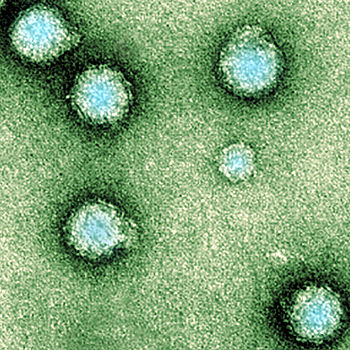Chikungunya Virus: Difference between revisions
imported>Jesal Vyas |
imported>Jesal Vyas |
||
| Line 38: | Line 38: | ||
== Genome structure: == | == Genome structure: == | ||
The virion consists of an envelope and a nucleocapsid. The genome consists of a single-stranded, positive-sense RNA molecule of approximately 12000 nucleotides long. The 5’ end is capped with a 7-methylguanosine while the 3’ end is polyadenylated. A subgenomic positive-strand RNA referred to as 26SRNA is transcribed from a negative-stranded RNA intermediate. This RNA serves as the mRNA for the synthesis of the viral structural proteins. Alphaviruses have conserved domains that play an important role in the regulation of viral RNA synthesis. These domains are found at the 5’ and 3’ ends as well as at the intergenic region. Virions are spherical and measure about 70nm in diameter. Surface projections are glycoprotein spikes covering the surface evenly. | |||
== Interesting Features: == | == Interesting Features: == | ||
Revision as of 14:51, 13 May 2009
Classification
GROUP: GROUP IV SINGLE STRANDED POSITIVE SENSE RNA
FAMILY: Togaviridae
GENUS: Alphavirus
SPECIES: Chikungunya virus
ORDER: not assigned
VIRUS ACCESSION NUMBER: 73001507
ICTVdB VIRUS CODE: 00.073.0.01.007.00.000.002.
ICTV approved acronym: CHIKV
Description and significance:
Chikungunya virus is an arthropod borne virus from the genus Alphavirus and family Togaviridae. It was first isolated in Tanzania, Africa in 1953 and has sporadically caused human epidemics in South-east Asia, southern India. Chikungunya is a zoonotic virus with a life cycle that principally involves primates and the Aedes mosquitoes. Humans that are infected may develop relatively high viremias and fever that can elevate up to 104 degrees Fahrenheit. Aedes aegypti (also called the yellow fever mosquito) is the primary transmission agent for Chikungunya. It is usually found in tropics and that is the reason it is predominantly seen in Asian countries. Chikungunya has also spread across the globe in recent years and remains a viral disease with no anti-viral medication available. The clinical picture is characterized by a sudden onset of fever, rash and severe pain in the joints. The name Chikungunya comes from the Swahili language for stooped walk, reflecting the physique of a person suffering from the disease. Chikungunya fever is also called the “bone-breaker fever”. The family Togaviridae includes viruses like O’nyong nyong and Igba Oro, which are closely related to Chikungunya and induce the same disease in humans.
Natural Host:
The virus is transmitted by Aedes aegypti and Aedes albopictus. Virus infects during its life cycle arthropod and vertebrate hosts. Viral host belongs to the Domain Eucarya, Kingdom Animalia, Phylum Arthropoda and Chordata, Subphylum Hexapoda; Class Insecta; Subclass Pterygota; Order Diptera.
Severity and Occurence of the Disease
Infection can affect the nervous system or the musculo-skeletal system. General symptoms include fever, headache, maculopapular rash, arthralgia, myalgia, photophobia, lymphadenopathy. Infection is usually acute or chronic, more than 12% of patients with Chikungunya develop chronic joint pain. Prevalence of viral infection is seasonally dependent and incidences of the virus are usually noticeable in summer and wet seasons. The incubation period lasts usually two to four days followed by a recovery in five to seven days. The virus can be detected during the first 48 hours of disease and maybe detected as late as four days in some patients. The virus is known to occur in tropical regions. Viral host lives under aerobic conditions and lives in the atmosphere where it is wet. During 2005-2006 twelve cases of Chikungunya fever were diagnosed in the United States (ProMED 2006a). In India there have been at least hundred thousand cases reported with two confirmed fatalities. Infections may occur in areas that are not considered endemic but travel and globalization increases the possibility of epidemic outbreaks in other regions around the globe. Below is a list of some Chikungunya outbreaks: • Tanzania in 1953 (first recoded outbreak) • Kolkata, India in 1963 • Port Klang, Malaysia in 1999 • 237 deaths and 33% of people infected in Reunion islands in 2006-2007 • Italy in 2007 • Kerala in 2007
Genome structure:
The virion consists of an envelope and a nucleocapsid. The genome consists of a single-stranded, positive-sense RNA molecule of approximately 12000 nucleotides long. The 5’ end is capped with a 7-methylguanosine while the 3’ end is polyadenylated. A subgenomic positive-strand RNA referred to as 26SRNA is transcribed from a negative-stranded RNA intermediate. This RNA serves as the mRNA for the synthesis of the viral structural proteins. Alphaviruses have conserved domains that play an important role in the regulation of viral RNA synthesis. These domains are found at the 5’ and 3’ ends as well as at the intergenic region. Virions are spherical and measure about 70nm in diameter. Surface projections are glycoprotein spikes covering the surface evenly.
Interesting Features:
How does this organism cause disease?
What makes it biologically interesting?
Its application to Biotechnology... its medical importance... major research findings made with it... what's cool about myxoma virus as an organism:
Current Research:
References:
